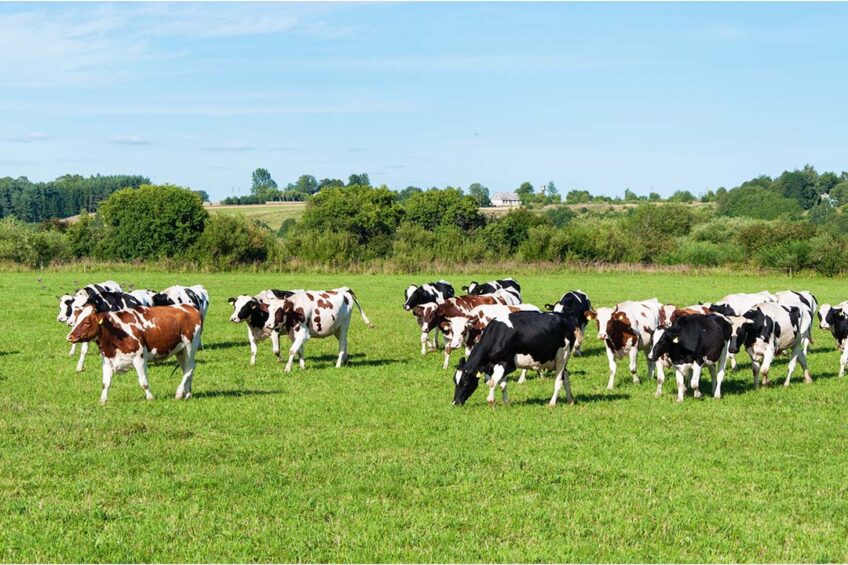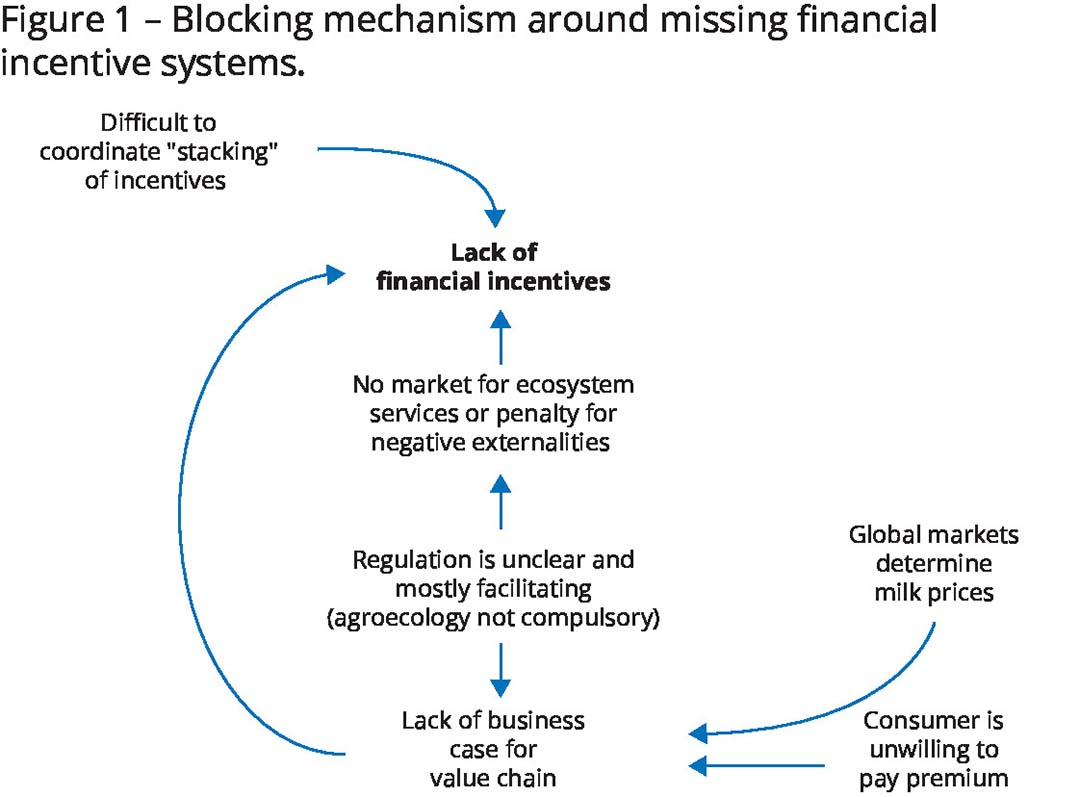Accelerating regenerative dairy farming

Regenerative agriculture aims to provide a way to adapt to a changing climate by regenerating landscapes while meeting the social and economic needs of farmers and their communities, that is, balancing the interests of farmers, society and the environment. This report, which is based on several studies, highlights how to accelerate the adoption of regenerative dairy farming.
In brief, regenerative agriculture focuses on soil conservation to regenerate ecosystem services in line with nature-inclusive farming, also aiming to achieve economic and social sustainability in the face of changing climate conditions. Researchers find that dairy done well and regeneratively supports one or more of the following regenerative farming principles:
- Livestock integration
- Minimising soil disturbance
- Protecting soil surface and maintaining living roots
- Encouraging plant diversity or balanced ecosystems
Challenges
Accelerating regenerative dairy farming starts with understanding the possible barriers to its adoption. Using the Dutch dairy farming sector, in a recent study published in the Journal of Agricultural Systems, researchers fromUtrecht University identified barriers that hinder what they called ‘nature-inclusive’ dairy farming.
The researchers identified 5 key blocking mechanisms that hinder the adoption of nature-inclusive agriculture in the Dutch dairy sector:
- Insufficient economic incentives for farmers
- Limited action perspective or motivation for adoption
- Lack of a concrete and shared vision for a regenerative agriculture system
- Lack of nature-inclusive-specific and integral knowledge
- The influence of the dominant agri-food regime on the innovation system for nature-inclusive agriculture, which is connected to each of the other mechanisms.
Accelerating regenerative farming
Fostering a common understanding
In their study published in Frontiers in Sustainable Food Systems, researchers found that understanding the meaning of regenerative agriculture is the first step to its adoption as wide variance in the definitions used may lead to uncertainty about what different actors or policymakers mean when they talk about regenerative agriculture.
They suggested that it’s helpful for individual users of the term ‘regenerative agriculture’ to define it comprehensively for their purpose and context; common understanding is crucial for implementing policies, including certification programs and payments for carbon sequestration programs, they said.
Supply chain support and market premiums
It was found that incentives from the supply chain could help foster the adoption of regenerative dairy farming, however, ‘stacking’ multiple incentives or subsidies from different sources that are sometimes available (e.g., from government agencies, the supply chain or nature protection organisations) is difficult to coordinate.
In addition, the market’s focus on export and the lack of markets for ecosystem services provided by, for example, nature-inclusive dairy farming discourages farmers from adopting the system. In the Dutch dairy sector, it was found that the benefits that nature-inclusive agriculture provides, such as higher biodiversity levels, improved water quality and carbon sequestration, are not captured in current market prices or financial incentives.
On the other hand, efforts by the dairy industry and civil society designed to develop labels and certification of nature-inclusive practices are ideal, but such labels also include a price premium of which there is a lack of willingness from supermarkets to pay — a major barrier to the development of markets for nature-inclusive dairy.
Increasing financial incentives
 The lack of a business case for regenerative agriculture and insufficient economic incentives for farmers negatively influence the system functions of resource mobilisation and entrepreneurial activity. Farmers do not receive sufficient premiums from the value chain (Figure 1), including consumers, supermarkets, and cooperatives, to stimulate a transition to regenerative agriculture; farmers are price takers given the export orientation of the sector.
The lack of a business case for regenerative agriculture and insufficient economic incentives for farmers negatively influence the system functions of resource mobilisation and entrepreneurial activity. Farmers do not receive sufficient premiums from the value chain (Figure 1), including consumers, supermarkets, and cooperatives, to stimulate a transition to regenerative agriculture; farmers are price takers given the export orientation of the sector.The suggestion raised was better regulation and binding agreements which would oblige value chain actors to account for biodiversity and ecosystem services in product prices, and set penalties for negative externalities such as water pollution or soil depletion.
Forage or pasture-based insurance programmes
In their research findings published in the Journal of Soil and Water Conservation, researchers found that risk reduction programmes for livestock producers are limited when compared to those for crop producers. “While a revenue protection programme for livestock producers does exist, the more relevant federal crop insurance programme for pasture-based livestock producers would be ideal as it creates a safety net for pasture-based livestock producers to maintain perennial cover,” they said, adding that with accurate measurement of local forage values, the insurance programmes would cover forage crop losses due to drought.
Improving knowledge transfer
Focusing on Dutch dairy farmers adopting nature-inclusive farming as an arm of regenerative farming, researchers found that there are obstacles to knowledge transfer that have to be fixed; knowledge development tends to be a top-down, expert-driven process without sufficient involvement from farmers and an independent extension or information service is rare, a result of privatisation and the prevalence of public-private partnerships as a model for knowledge development.
To be specific, knowledge is often provided by commercial actors whose business models depend on the high-input/high-output farming model while independent advisors are concerned their advice to switch to regenerative agriculture may lead to lower revenue or other risks contrary to expectations of growth. Moreover, agricultural education is still heavily focused on the conventional model.
Use of models
In a recent study published in Agricultural Systems, researchers at Wageningen University created a modelling framework which allows the redesign of diverse farming systems and assessment of ecosystem services associated with regenerative agriculture in diverse pedo-climatic conditions; using a Dutch dairy farm as a case study, they combined two models (Soil Navigator and FarmDESIGN) to consider soil attributes on the field scale and environmental and socio-economic outcomes on a farm scale.
“For regenerative agriculture to be meaningful for diverse farming systems, we need methods that provide insight into the efficacy of regenerative management to meet multiple ecosystem services within local contexts. As such, our modelling framework can be used by researchers as a tool to help various stakeholders assess and redesign farms based on the objectives of regenerative agriculture,” they said.
Remote sensing and machine learning
To successfully realise improved land-use sustainability through more timely monitoring of pasture sustainability indicators, more robust approaches are needed. Research shows that, while a range of commercial technologies exists, outputs from many of these applications are site-specific and others have not been validated yet. This raises questions as to how well such applications predict pasture biomass outside their zone of calibration.
In a 2023 study in the journal Land, researchers examined the potential of regenerative agriculture as an adaptive grazing management strategy in ruminants to minimise bare ground exposure while improving pasture productivity. They found that, in combination with remote sensing techniques, machine learning techniques including artificial neural networks, random forest, and support vector machine are not site-specific and can be used to effectively retrieve pasture biomass estimates.
Conclusion
Putting it all together, a few remarks can be summarised relating to the adoption of regenerative dairy farming, as follows:
- There is a need for a common understanding of what regenerative dairy farming implies.
- Regulatory changes are needed to bring about a level playing field for all farmers in the dairy sector; valuing ecosystem services provided by regenerative farming as well as accounting for the ecosystem ‘disservices’ brought about by conventional agriculture.
- The creation of markets for regenerative agriculture-based products and the provision of incentives to farmers for transition costs is important.
- Architects of transition strategies must take into account the potential socio-economic, cultural, and political impact of such strategies, and consider a holistic approach.
- There is a need to transform current regimes, in particular, the currently dominant economic paradigms of growth and yield maximisation.






